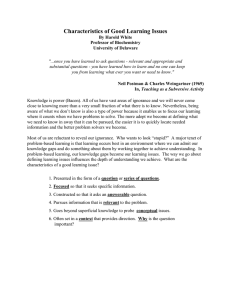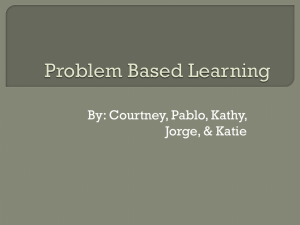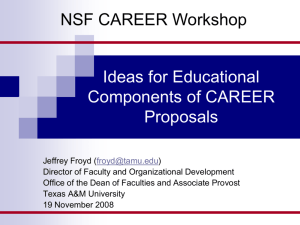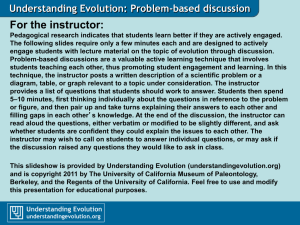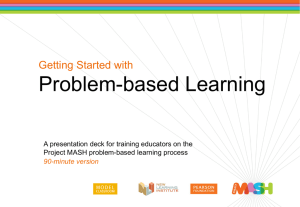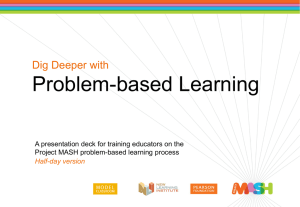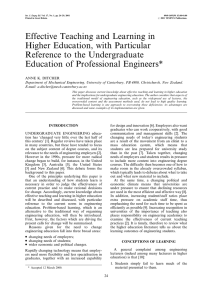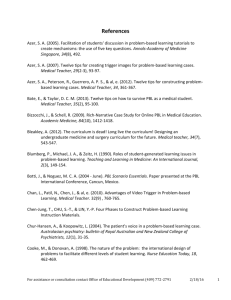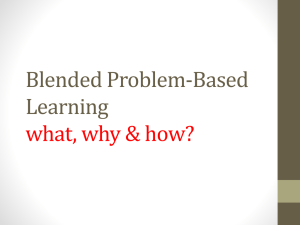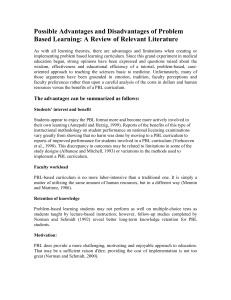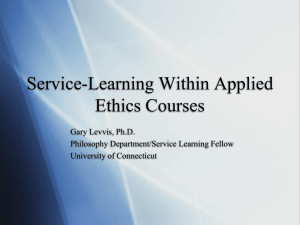Problem-based Learning
advertisement
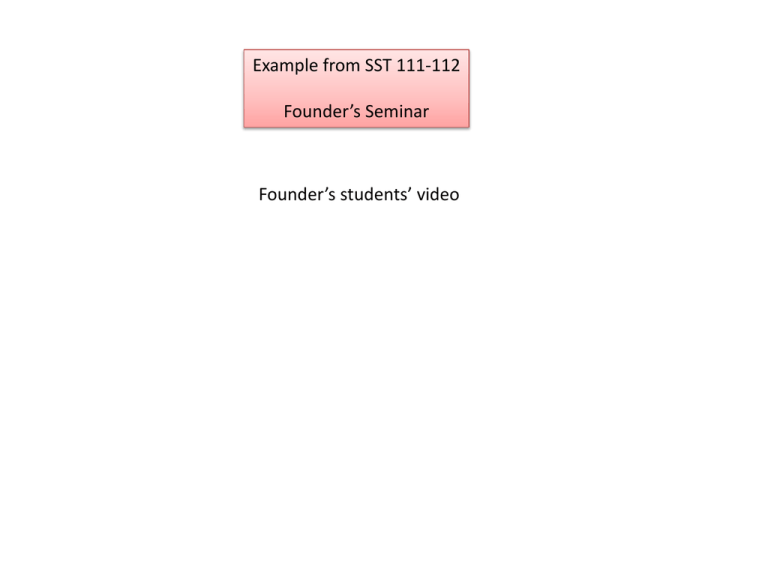
Example from SST 111-112 Founder’s Seminar Founder’s students’ video Problem-based Learning: As Learners and as Teachers Julie G. McIntyre & Sybillyn Jennings May College 2013 This session offers a very brief overview of the range of approaches referred to as problem-based learning. We will provide examples of using problem-based learning in different classes and give participants a chance to try this sort of inquiry themselves. Then we will turn to the other sense of problem-based learning; namely, how to address students’ problems in preparing for exams and organizing their ideas in writing papers. Again, we will offer some examples of methods that support students in their learning. From Problem-solving To Problem-based Learning Q: Why do we, teachers, give our students, learners, problems to work on? Q: How do we decide which problems to give which students? Q: How do we design problems that will improve practice? Q: How do we design problems that will advance and deepen thought? A Family of Approaches Patient diagnosis Case-based learning Problem-posing the training of thought Problem-based learning Project-based learning Inquiry learning Questioning Ad quem Ab quo “Thinking as reflective operation reveals... (a) a state of perplexity, hesitation, doubt (b) an act of search or investigation directed toward bringing to light further facts which serve to corroborate or to nullify the suggested belief. “ “...but if we are willing to extend the meaning of the word problem to whatever— no matter how slight and commonplace in character—perplexes and challenges the mind so that it makes belief at all uncertain, there is a genuine problem or question involved in this experience....” John Dewey How We Think 1910, ch. 1, p. 9 Example from ENG/PSY 237 Principles & Applications of Language Founder’s Seminar SST111-112 April 2013 A Sample Inquiry to Try Does your discipline use the notion of “stage”? If it does, what problem or problems is the idea of stage working to solve? If it does not, why is the idea of stage not needed? Evidence-based Strategies for Teaching “Generation Me” Q: Are there really generational differences, or are these perceptions biased by age, experience, and a bit of faculty burnout? Recent generations of emerging adults have been described as: Higher in self-esteem than previous generations Being assertive Having narcissistic personality characteristics Holding high expectations for the future Thinking they are above average in-Academic ability Writing ability Intellectual self-confidence Their drive to achieve Adapted from Twenge 2013 BUT, are these self-serving biases, not based in reality? Standardized test scores have remained stable or decreased over time Creativity scores have declined Self-esteem and achievement show negative correlation – a reversal of direction Unrealistic Optimism Graduate high school with As Plan to earn a graduate degree Predict they will be in the top 20% of high performers in their adult jobs How can we use this information on generational differences to tailor teaching strategies and improve learning outcomes? Recommendations Be very specific about requirements Provide frequent feedback Include plenty of images and video clips Provide multiple opportunities for a variety of interactive learning Hold students accountable for reading Be explicit about the purpose of assignments Example from PSY 208 Developmental Science “A question is more spacious than a statement, far better suited to expressing wonder.” M. Robinson References and Resources Baldwin, M.( 2010). Problem-based learning: Seeking the learning sense. www.samford.edu/ pbl. Brown, S.I. and Walter, M. (1990, 2nd ed). The art of problem posing. Hillsdale, NJ: Lawrence Erlbaum. Dewey, J. (1910/1991). How we think. Buffalo, NY: Prometheus Books. Kahneman, D. (2011). Thinking fast and slow. NY: Farrar, Strauss and Giroux. McDaniel, M. A., Agarwal, P. K., Huelser, B. J., McDermott, K. B., & Roediger, H. L. (2011). Test-enhanced learning in a middle school science classroom: The effects of quiz frequency and placement. Journal of Educational Psychology, 103, 399-414. McDaniel, M. A., Anderson, J. L., Derbish, M. H., & Morrisette, N. (2007). Testing the testing effect in the classroom. European Journal of Cognitive Psychology, 19, 494-513. Robinson, M. (1998). Psalm eight, p.227-244. The death of Adam. Boston: Houghton Miflin. Rogers, C. Kirschenbaum, H. and Henderson, V. (Eds.) (1989).The Carl Rogers reader. Boston: Houghton Miflin Harcourt. Savery, J.R. (2006). Overview of Problem-Based Learning: Definitions and Distinctions, Interdisciplinary Journal of Problem-Based Learning, 1(1). Available at: http:// dx.doi.org/10.7771/1541-5015.1002 Schon, D.A. (1983). The reflective practitioner. NY: Basic Books. Swan, K. , Vahey, P. , van 't Hooft, M. , Kratcoski, A. , Rafanan, K. , Stanford, T. , Yarnall, L. , & Cook, D. (2013). Problem-based Learning Across the Curriculum: Exploring the Efficacy of a Cross-curricular Application of Preparation for Future Learning. Interdisciplinary Journal of Problem-based Learning, 7(1). Available at: http://dx.doi.org/ 10.7771/1541-5015.1307 Tan, Oon-Seng (2003). Problem-based learning innovation: Using problems to power learning in the 21st century. Cengage Learning. Twenge, J.M. (2013). Teaching generation me. Teaching of Psychology, 40, 66-69.
